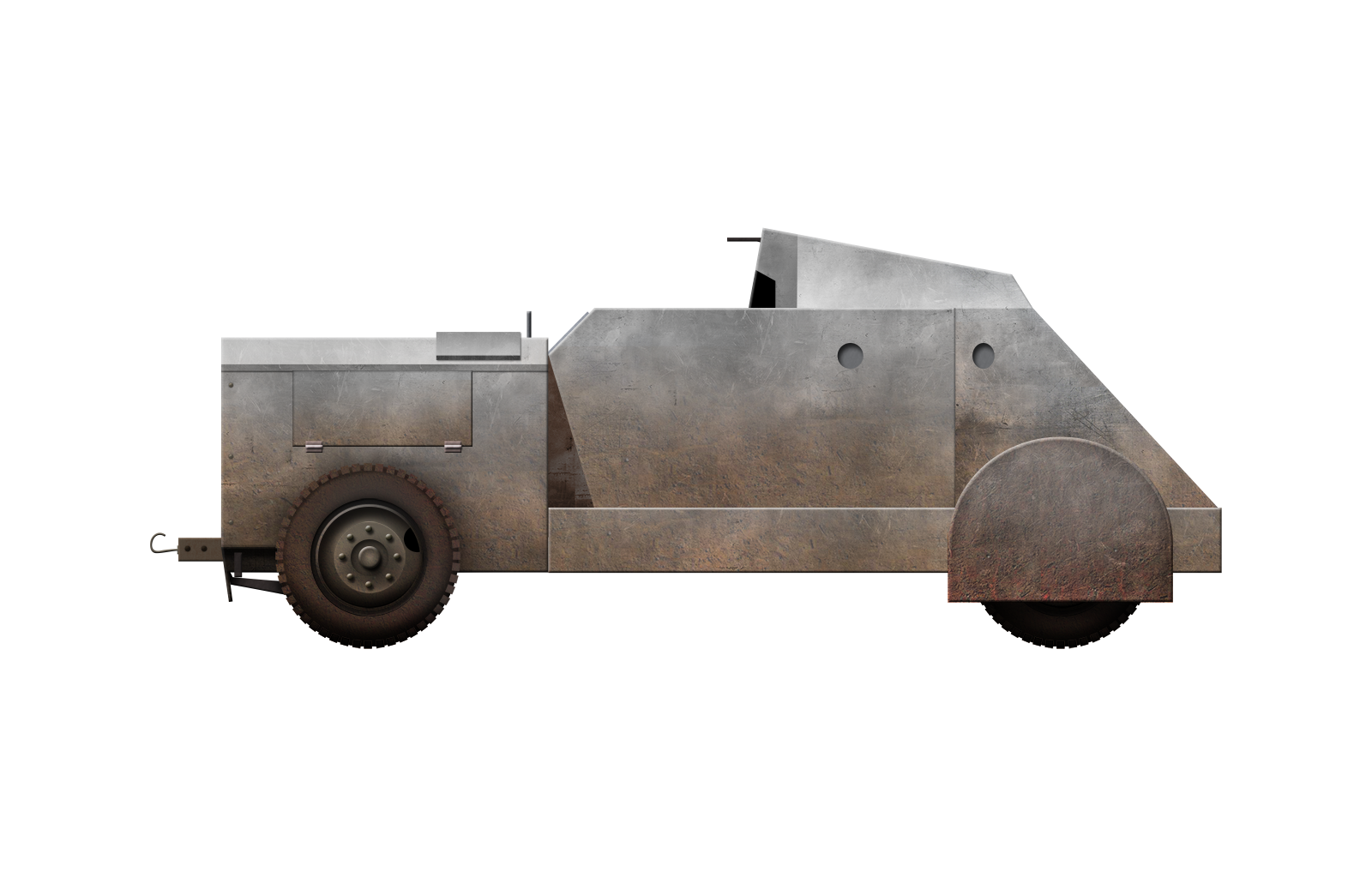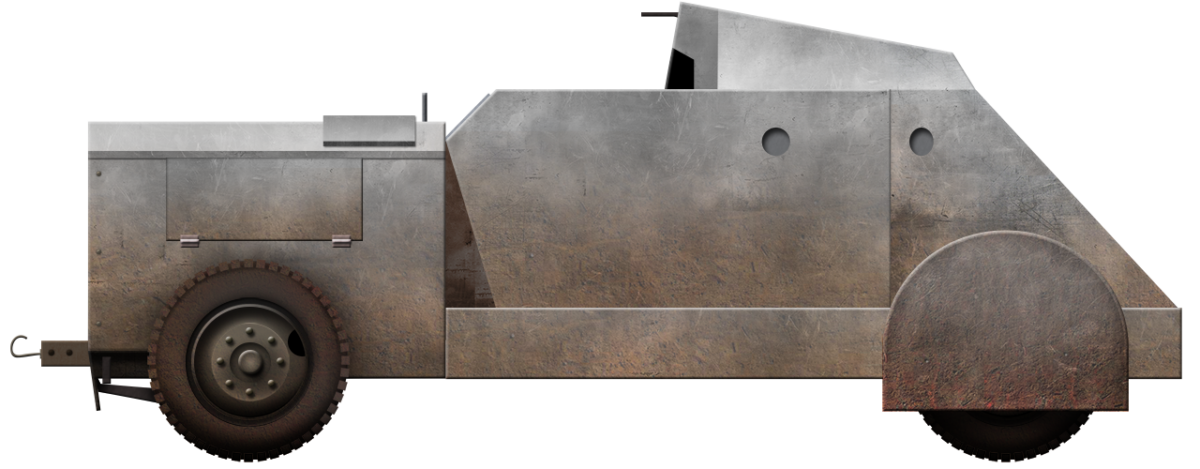 Yugoslav Partisans (1942)
Yugoslav Partisans (1942)
Armored Truck – 2 Built
During World War II, Yugoslavia was a stage of struggle where a large number of different types of armored vehicles were used by all warring parties. While these were not necessarily the more famous ones, such as the Tiger and Panther, those that were used were a mix of older and newer models, field modifications and improvisations. The Yugoslav Partisans were credited with the construction of some unusual vehicles. These included two locally built armored vehicles based on truck chassis.
History
While the conquest of the Kingdom of Yugoslavia proved to be an easy task for Germany and its allies, holding these territories proved to be much more difficult. This was mainly due to two resistance movements that were actively engaged in sabotage, destroying railways and bridges, attacking isolated occupation units’ positions and strongpoints, etcetera. Despite attempts to suppress these attacks, the resistance movements, especially the Communist Partisans, grew rapidly, forcing the Germans to introduce an ever-larger occupation force.
To combat the ever-increasing Axis presence, the Partisans used any available weapon that was either leftover from the Yugoslav pre-war army or captured from the enemy. The Partisans also tried to locally construct their own armored vehicles. One such vehicle was an improvised tank, which after the war was referred to simply as the ‘Partizanski tenk’, Partisan tank.
During the first half of 1942, the Partisan units in the area of Bosanska Krajina (Bosnia) were engaged in heavy fighting with NDH (Independent State of Croatia) and German forces. The enemy operated a number of armored vehicles, such as tanks, tankettes, and armored cars. While fighting NDH forces in May 1942, the Partisans managed to capture two tankettes and used them against their former owners, but these were lost in July 1942. In an attempt to counter the enemy’s advances and to increase their own firepower and protection, after liberating a mine in Ljubija with its workshop in mid-May 1942, the Partisans began working to construct two armored trucks. While capturing this workshop provided the Partisans with the necessary tools to build these vehicles, it is unknown how precisely they did it and where they managed to get the armor plates. Being a mine area, it is possible that they cannibalized wagons or carts for spare parts, but as historical sources are scarce, so this is just speculation.
Name
These two vehicles never received any official names. For the sake of this article, the name ‘Partizanska oklopna vozila’ will be used, which simply means Partisan armored vehicles.
Built by the NDH?
D. Predoević (Oklopna vozila i oklopne postrojbe u drugom svjetskom ratu u Hrvatskoj) states the possibility that the construction of these two vehicles was actually initiated by NDH forces. He explains that, while the Partisans managed to capture Ljubija on 17th May 1942, they remained there up to 10th June, when they were forced to retreat. It may have been impossible to complete these two vehicles from scratch in this short period of time. A possible explanation is that the Partisans captured NDH vehicles that were under construction with available parts. The NDH force did, in fact, make several armored vehicles during this period, so they had skill and experience to do so. While there may be some truth in this, due to the lack of information about their precise history, it is impossible to say for sure.

The design
For the basis for these two vehicles, a FIAT and a Magirus truck chassis were used. These two were probably captured from the enemy or were found in the Ljubija workshop. In order to put the new armored body on these two trucks, most parts like the cabin, rear cargo bed etcetera had to be removed, leaving only the chassis and the engine.
The rear wheels were fully protected by semicircular armored plates. While the Partisans never truly completed them, the vehicles captured by the advancing enemy lacked the protection of the front wheels which were later added by them.
The engine compartment was completely covered with mostly flat armor plates, except for the roof which had angled plates. On both sides and top of the engine compartment, four hatches were added, possibly to be used for maintenance of the engine and to act as ventilation ports. Also on the engine’s right side, there was a small antenna but, as the Partisans lacked radios, its purpose is unclear. In addition, there were two towing hooks added in front of the engine. These were probably added to help tow these vehicles in case of any of them slipping off the road or being bogged down in muddy terrain.

Behind the engine compartment was the driver and crew (passenger) compartment. The driver was positioned on the vehicle’s left side and had a small observation hatch without a visor slit. Behind him, there was room for 6 to 8 men. Being fully enclosed, they could fire at the enemy through four round firing ports, two on each side.
On top of the crew compartment, a smaller superstructure with angled sides was added. In front of it, a small opening was left, likely to be used by a gunner to fire a machine gun. While the available pictures do not show any weapon fit in, an educated guess would suggest that this was its main purpose. The type of weapon used for this purpose is unknown, as the Partisans used a variety of different weapons, so it could be any one of them. The use of an anti-tank gun is highly unlikely due to the opening’s small size and the fact that, at this time in Yugoslavia, these weapons were generally rare. On top of this superstructure, a large pentagonal hatch door was added. Besides the driver, gunner, and the passengers, it is unknown if the vehicles had another crew member that served as the commander.
The rear of these vehicles appears to have been protected by a highly angled armor plate. To the rear, it would have been logical to have put a hatch door for the crew and the passengers to enter/exit the vehicle safely. Firing ports may have also been added on the rear. But, as no pictures of the vehicles from this side exist, this is all just speculation.
Due to lack of information, there is little known about its construction, besides what can be observed from the few photographs that have survived. For example, the thickness of the armored plates used is unknown. It is also unknown if the quality of these plates would provide any real protection from small-caliber fire. One of the few things mentioned in the sources is that the vehicle was around 5 m long.
Identification of the chassis used
While the few available sources mention that these two vehicles were built using a FIAT and a Magirus truck chassis, they do not state which precise types were used. While there is only one photograph of the Magirus chassis built, due to its poor quality, identification is impossible.

For the second vehicle, thanks to the better quality photograph, it is easier to identify the precise type used. While most parts of the trucks used were removed and replaced with an armored body, the wheels were left unchanged. Based on them and on the fact that the sources mentioned that a FIAT truck was used, the options can be narrowed down. The most likely type used was a FIAT 621. Some 50,000 FIAT 621 were built for the Italian Army (and civilian use) in several different versions. The main reason for this assumption is the design of the wheel rims, which consisted of eight bolts that held the wheel and the two larger round shaped openings, both of which were present on the FIAT 621. If this was the case, the FIAT 621-based vehicle was powered by a FIAT 324 53 hp diesel with a maximum speed of 60 km/h. Due to extra weight, the maximum speed on this vehicle was much lower. The weight was around 2.5 tonnes, but with added armor plates and full crews, the weight probably increased by 1 tonne or even more.


Different accounts of its use in combat
The potential usage of these two vehicles is not completely clear and the sources give different accounts. According to B. B. Dumitrijević and D. Savić (Oklopne jedinice na Jugoslovenskom ratištu 1941-1945), the Partisans, due to the speed of advance of the enemy forces, never had a chance to complete these two vehicles. In their hurry to escape the enemy, these two incomplete vehicles had to be abandoned. It seems that the enemy advance was so quickly that the Partisans did not have time to destroy or even sabotage them, which was their common practice during the war.
D. Predoević (Oklopna vozila i oklopne postrojbe u drugom svjetskom ratu u Hrvatskoj), on the other hand, states that, according to Partisan High Command dispatches, these two vehicles were to be used in an attempt to drive the enemy forces from Sanski Most. Both had specific tasks which were to be achieved. Ultimately, this attack failed, and the two vehicles disappeared from the Partisan records.
Final fate
After June 1942, the Partisans were forced to retreat from Ljubija. The two vehicles that they constructed were captured by the advancing enemy units. The circumstances under which this occurred are not known. Depending on the two previous combat use scenarios, they could have either been captured in the Ljubija workshop or during the Partisan failed attack attempt on Sanski Most. The sources also disagree about who captured them, as both German and NDH forces are credited with this.
Regardless of the circumstances, these two vehicles found their way into German hands. Unlike the photograph taken during the capture of one of the two vehicles, the vehicle in German service had its forward wheels covered with armor protection. These two would be used by the Germans during the Kozara Offensive, in an attempt to destroy Partisan forces stationed there. Their ultimate fate is unknown, as it appears that, after this operation, they were not used, or at least there is no record of them.

Conclusion
The Partisan forces were, due to a lack of resources, often forced to use what they had at hand. These two vehicles were one example of such ingenious solutions to provide their troops with armored cover and increased firepower. Due to the rapid enemy advance, these vehicles were probably never used in combat by their creators. But, despite this setback, the Partisans would continue on with the fight against the enemy and even built even more strangely vehicles using a combination of Allied tanks and German weapons.

This article has been sponsored by East Coast Hardware, a Hardware, Home and Garden, Automotive and Sports shop. If you need parts for your car (vintage or replica military vehicle), do check them out!
Specifications |
|
| Crew | Commander, Driver, Gunner, and 6 to 8 passenger |
| Dimensions | 5 m long |
| Weight | approximately 5 tonnes |
| Engine | Possibly FIAT 324 53 hp diesel engine |
| Armament | One unspecified machine gun |
| Armor | unknown but probably low thickness of a few millimeters |
Source:
B. B. Dumitrijević and D. Savić (2011) Oklopne jedinice na Jugoslovenskom ratištu 1941-1945, Institut za savremenu istoriju, Beograd
D. Predoević (2008) Oklopna vozila i oklopne postrojbe u drugom svjetskom ratu u Hrvatskoj, Digital Point Tiskara
FIAT Archives of Turin


One reply on “Partizanska Oklopna Vozila”
Excellent article – I have always been interested in “home-made” AFVs.